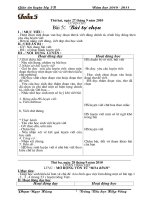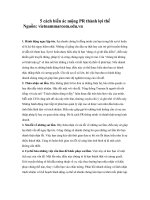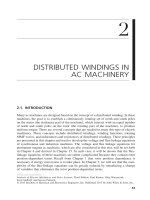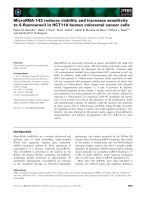Topic 5 capacitance in AC circuits topic a5
Bạn đang xem bản rút gọn của tài liệu. Xem và tải ngay bản đầy đủ của tài liệu tại đây (112.13 KB, 29 trang )
Solve problems in single and threephase low voltage circuits
Part A
Topic 5: Capacitance in
AC Circuits
Capacitance in AC Circuits
Capacitive Component
–
–
A device that consists of a two metal plates
separated by a dielectric (insulator).
A capacitive component’s function is to store
energy in an electrostatic field.
Capacitance in AC Circuits
Key Characteristic
–
–
–
A capacitive component will ACT TO STORE
ELECTRICAL CHARGE THAT WILL OPPOSE
THE APPLIED VOLTAGE (and therefore current)
It achieves this by storing a negative charge on
one plate and a positive charge on the other.
How strongly it does this is indicated by the
capacitor’s CAPACITANCE, symbol C, measured
in Farads (F)
C
Capacitance in AC Circuits
Effect in an AC circuit
–
–
Since the voltage in an AC circuit is continually
changing (ie alternating between positive voltage
and negative voltage), a capacitor in an AC circuit
continually charges and discharges which then
opposes the change in voltage (and current).
As a result, the capacitor produces a constant
opposition to the flow of alternating current.
Capacitance in AC Circuits
This opposition to alternating current flow is
called CAPACITIVE REACTANCE.
XC =
Where:
–
1
2π ƒ C
Xc is the capacitive reactance in Ohms (Ω)
2π is a constant
– ƒ is the frequency in Hertz (Hz)
– C is the capacitance in Farads (F)
–
Capacitance in AC Circuits
Important!
–
–
CAPACITIVE REACTANCE is an opposition to
current flow like RESISTANCE, but it is NOT the
same as resistance, even though both are
measured in Ohms.
As a result, CAPACITIVE REACTANCE and
RESISTANCE can NOT be simply added to find
the total opposition to current flow in a circuit.
Capacitance in AC Circuits
Key Advantage
–
–
Ability to produce better operation for circuits
containing highly inductive loads.
Ability to limit AC current flow without consuming
any power.
Capacitance in AC Circuits
Examples of Capacitive Components
–
–
–
Capacitor
Capacitor banks (for power factor correction)
Filter or tuning circuits
Capacitance in AC Circuits: Ohm’s
Law
VC
IC
VC
C
IC
XC
VS
ƒ
Simple Capacitive Circuit
Ohm’s Law – capacitive component
Capacitive Reactance: Exercises
C=47µF
C =?
IC=0.723A
IC=?
VS=230V
VS=230V
ƒ=50Hz
ƒ=50Hz
Q1. Determine:
Q2. Determine:
Capacitive reactance XC, and
Capacitive reactance XC, and
Current though capacitor Ic
Capacitance of capacitor C
Capacitive Reactance: Answers
Q1
XC = 67.73Ω
IC = 3.40A
Q2
XC = 318.12Ω
C = 10μF
Capacitive Reactance: Exercises
A 230V, 50Hz AC supply is to be applied to a
ceiling fan circuit using a capacitor speed
control switch. If the current for the ceiling fan
motor needs to be reduced to 0.362 Amps for
the “Low” setting, determine the appropriate
value of capacitance required by for this
setting (assume the motor has no opposition
to current flow).
Capacitive Reactance: Answers
XC = 635.36Ω
C = 5.01μF
Capacitance in AC Circuits:
Capacitance in Series and Parallel
C1
C1
C2
VS
ƒ
C2
IS
VS
ƒ
Capacitive Reactance in Parallel
Capacitive Reactance in Series
X C Total= X C1+X C2+…
1
X C Total
= 1 + 1 +…
X C1 X C2…
Series Capacitive Circuit
VC1
VC2
Kirchoff’s Voltage Law
C1
C2
•The ‘sum’ of the voltage drops in
the circuit will equal the supply
voltage
Vs = VC1 + VC2+…
VS
ƒ
[Purely capacitive circuit only]
Parallel Capacitive Circuit
IC1
IC2
IS
C1
Kirchoff’s Current Law
C2
•The ‘sum’ of the currents
entering a junction will be equal to
the sum of the currents exiting the
junction.
VS
Is = IC1 + IC2+…
ƒ
[Purely capacitive circuit only]
Capacitance in AC Circuits
Exercises on series / parallel combinations
Capacitance in AC Circuits:
Capacitance in Series and Parallel
C1 = 15μF
VS=230V
ƒ=50Hz
Determine the following:
•XC Total
•IS
•VC2
C1 = 220μF
C2=33μF
C2 = 680μF
IS
VS = 32V
ƒ=50Hz
Determine the following:
•XC Total
•IS
•IC1
Capacitance in AC Circuits
Series Answers
–
XC1 = 212.2 Ω
–
XC2 = 96.5 Ω
–
XC Total = 308.7 Ω
–
IS = 0.75A
–
VC2 = 71.9V
Capacitance in AC Circuits
Parallel Answers
–
XC1 = 14.47 Ω
–
XC2 = 4.68 Ω
–
XC Total = 3.54 Ω
–
IS = 9.04 A
–
IC1 = 2.21 A
Review
At this stage, you should have a clear understanding
of Capacitance in AC circuits, including:
–
–
–
–
–
Understand the concept of capacitive reactance;
Understand the application of Ohm’s Law to capacitive
circuits;
Understand and be able to apply Kirchoff’s Voltage law to a
purely capacitive circuit;
Understand and be able to apply Kirchoff’s current Law to a
purely capacitive circuit;
How to make calculations involving V, I, and XC in
series/parallel circuits.
Phase Relationship between
Voltage and Current
Resistive Circuit
Phase Relationship between Voltage
and Current: Resistive Circuit
V
R
‘V’ Waveform
‘I’ Waveform
I
I
V
VS
ƒ
Simple Resistive
Circuit
In-phase
Phasor diagram
Phase Relationship between
Voltage and Current
Inductive Circuit
Phase Relationship between Voltage
and Current: Inductive Circuit
‘V’ Waveform
V
‘I’ Waveform
I
L
V
VS
ƒ
Simple Inductive Circuit
I
Out-of-phase LAG by
900E
Phasor diagram









